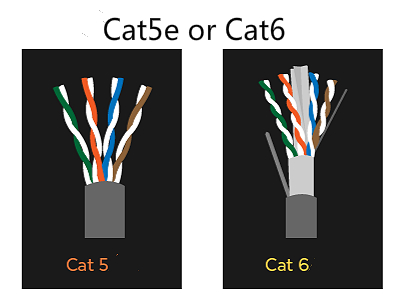Cat5e and Cat6 Ethernet cables both typically use 4 twisted pairs in each cable for delivering data and power at the same time. When we need to build a cable system, which one should we choose, Cat5e or Cat6?
Cat5e or Cat6: Introduction
Cat5e cable is the enhanced version of Cat5 cable, with the option to deliver data at 1000Mbps. It also can be used with Gigabit Ethernet. Cat6 cable comes out only a few years after Cat5e. This cable can support 10 Gigabit network. It offers lower crosstalk, higher signal-to-noise ratio than Cat5e cable. Cat6 is compatible with already installed Cat5e cabling. The table below lists the electrical performance of Cat5e and Cat6 cable.
| Items | Cat 5e | Cat 6 |
| Frequency Range | 1-100MHz | 1-250MHz |
| Delay | Same with TSB95 | Same with TSB95 |
| Delay Skew | Same with TSB95 | Same with TSB95 |
| Attenuation | Same with Cat 5 | 43% stricter than Cat5 |
| NEXT | 41% stricter than Cat5 | 337% stricter than Cat5 |
| PSNEXT | Same with Cat 5 | 216% stricter than Cat5 |
| ELFEXT | 5% stricter than Cat5 | 104% stricter than Cat5 |
| PSELFEXT | Same with TSB95 | 95% stricter than Cat5 |
| Return Loss | 26% stricter than Cat5 | 58% stricter than Cat5 |
Cat5e or Cat6: Differences
The following are the differences between Cat5e and Cat6 cable network cable.
Cat5e Network Cables can be only with 1000BASE-T, while Cat6 cable is available with 1000BASE-T, can also be used with 1000BASE-TX.
The price of Cat6 cabling system products is as 30%-60% as higher than that of Cat 5e products.
Cat 6 cabling systems engineering in the design, construction, management and other aspects of the requirements are relatively higher than Cat 5e cabling system.
Advantages of Cat6 Cabling System
(1) The main advantage of Cat6 cabling system is reflected on the 1000Mbps network support.
(2) Compared with Category 5e, Cat 6 cabling system has better anti-noise performance, can provide a transmission channel more transparent, more versatile, especially at high frequency.
(3) If use the PAM-5 coding technology of 1000BASE-T, 10Gbps Ethernet requires linear transmission performance at least 625MHz. Most of the cat 5e cables are only 150MHz or 250MHz, the standard cat5e cable also only requires 100MHz. Although Cat 6 has not been forced its performance to 625MHz, but for high bandwidth transmission it is a better medium. Many cable manufacturers provide the nominal 600MHz Cat 6 cable, this is an expectation of some applications may require higher performance.
(4) The average noise immunity at 600MHz of Cat6 cable system is higher than that of Cat5e.
(5) Cat 6 cable structure can withstand greater tension, in technology Cat6 has an absolute advantage over Cat5e cable.
Matters Should be Considered When Using Cat6 cabling
(1) Category 6 cabling system products must be compatible with two standards, namely mutual compatibility and downward compatibility.
(2) The real Category 6 cabling system products should be a complete solution, not just some wiring components.
(3) Since the outer diameter of Category 6 cable is wider than that of common Cat 5 cable, to make the engineering quality of category 6 cabling system and installation excellent, the requirement is very strict to the construction process.
(4) Whether choose Cat 6 cabling system products as the cabling system, must be closely combined with the actual situation of the project as a starting point.
Cat5e or Cat6?
Cat6 cable brings more advantages than Cat5e as described above. But the choice should be made depends on how frequently you use the internet in your business. If you require faster internet speeds, Cat6 is a good choice. It will provide you with enhanced performance and reduced crosstalk. If you don’t have the need for faster speed, and be happy with the current internet speeds, Cat5e is great. Cat5e is the “gold standard” of Ethernet cables and still does the job. If you need more information on the subject, be sure to talk to us via us@fs.com.
Related Articles:
The Advantage of Slim Cat6 Cable
